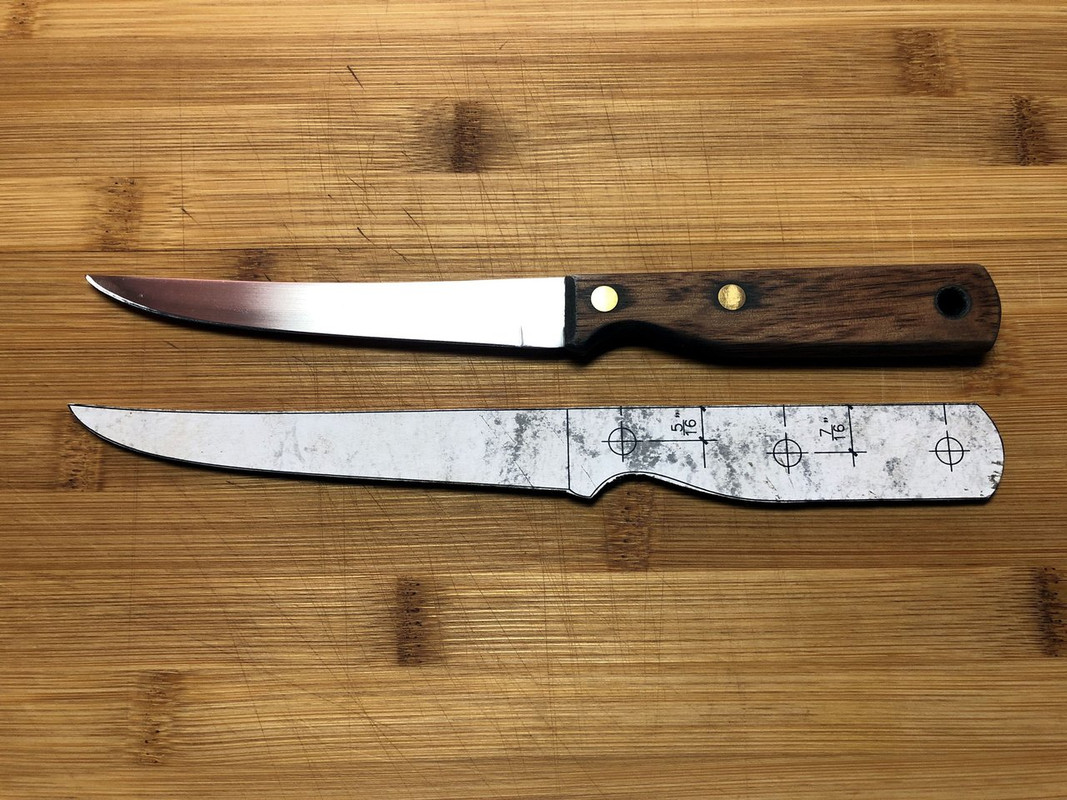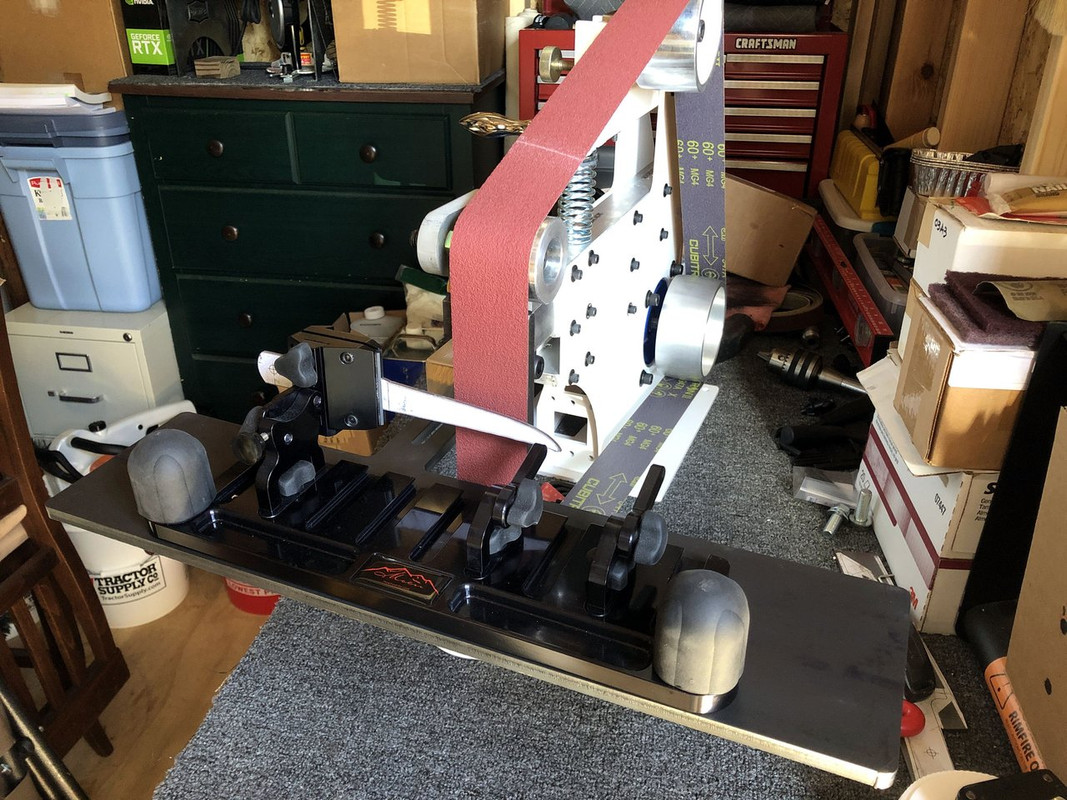OK, now your blade is polished. Keep it that way by wrapping tape to protect the smooth shiny bevels. The blue painter's tape is the best. Another trick is to wrap the blade with a layer of paper toweling, and then tape over that with the tape. This is easier to remove and requires less clean-up of the tape's adhesive. In any case, the blade should be well protected from sanding grit, tools and other hazards during the handle work.
Take your handle scales and look them over. Are they a good match? Is there a certain orientation that looks best (grain direction, burl pattern, etc.)? Are they the right material for the knife? Again, just as in the sanding, don't accept OK as good enough. If they look right, fine. If not, change them or modify them to be right.
Mark the inside of each scale and put an arrow towards the front and top. This sounds silly, but you would not believe how often one is put on or drilled backwards. Place the scales together, and tape them tightly.
The front end, where the ricasso will be, needs to be shaped and sanded before assembly. Saw/file it to any curve needed, sand it smooth, rounding up to the flat sides. Sand the ends to 800 grit or finer. They should be smooth and scratch free. This area will be impossible to sand and polish without ruining the blade finish once the handle is on the knife, so make sure it is right. If you are applying a finish to the scales, apply it to the ends and sand/buff/polish it now . The scales only need their front ends done right now, the rest can be a rectangle, you don't want to shape anything else yet.
I hope you remembered to drill the holes in the tang before HT, because that will be a lot harder to do now. Also, the reason you want to drill the holes a bit large is to allow for any miss alignment in drilling. I make the holes at least 1/16" larger than the rivet.
Lay the blade over the still taped together scales and position it where the scales should be. Use a clamp to hold it there and take a look at arm's length to check the positioning. Once it looks good, mark the exact center of each rivet/bolt/thong hole. Set the blade aside for the moment.
NOTE - It is best to determine the correct drill sizes on a piece of scrap wood before drilling the handle.
While the scales are still taped together, drill the front hole through both scales, using a drill press if available. Drill as straight and accurately as possible. Use a drill bit that is a little smaller than the pin/rivet that will go through that hole. Re-drill it with the correct size bit. The correct size is a few thousandths over the pin size, so a 1/8" pin gets a .130" hole, or there about. You should measure your pin stock to make sure of its size, as they vary in actual diameter. Now, take a piece of the rivet stock you will be using and check the fit. Sand the ends of each rivet to a slight chamfer to aid with insertion. Re-drill as necessary until the rivet goes through with little or no pressure needed. Leave the rivet in place. If using Corby bolts, drill both sides for the shoulder, and screw in a bolt. This step you just complete now has the two scales firmly locked together to make sure the rest of the holes will all align. Now it is time to drill the back rivet. Drill it the same way, inserting a rivet in the hole when ready. Continue to drill any other holes as needed, fitting the rivet/tube/etc. as you go. If you cut the rivets ¼" longer than the scales thickness the rivets will be ready to install during assembly. When all is done, remove the rivets/bolts/tubes and take the tape off the scales. Place on the blade and dry fit, going in the same order as before (front, rear, etc.). If there is any trouble going through the blade tang, re-drill that tang hole to make it allow the rivet to pass through. A carbide or diamond burr in a Dremel tool will enlarge it quickly. Once all is fitted with the blade in place, remove the pins again. Lay the tang on the inside of one scale, aligning the holes carefully, and gently clamp it in place. Trace around the tang with a pencil (avoid markers, as they can absorb into the wood and make stains that show later). Do the same for the other scale. Cut the excess off with a coping saw, or a band saw if available. You don't want to get any closer to the tang than 1/8". The rest will be filed/sanded away. If desired, do any pre-shaping needed. Check all fits again and if it is good, you are ready to assemble the handle. Tape the blade ricasso to keep the epoxy from running down the blade, leaving about ¼" of the ricasso exposed.
Gluing the handle on and finishing the knife:
This is a good time to talk about adhesives. The best way to assemble a handle is to glue and bolt it together. That way it is never coming loose. This is not always the way it is done, so the glue should be able to do the job by itself. With the exception of Corby and Loveless bolts, rivets are mainly just to prevent lateral blows from shearing the glue joint. Top grade structural epoxy is what you want for the job. Forget all the advertisement hype about super glues and Gorilla glues, etc. They all have things they do best, but for handles, epoxy is king. There are many types available, but the slowest curing time and maximum strength make for the best joint. Don't use 5-minute epoxy ever. Acraglass is a resin made for gun work, and is really good, but the 24-hour cure epoxies from any woodworking shop will be just as good, and much cheaper. I prefer System Three T-88. Get your epoxy resin from a place that moves a lot of glue to assure fresh resin. Mix the resin in a small disposable plastic cup (I use the 2oz. condiment cups). The ratio of hardener to resin is critical, so get it perfect. Using a scale is a good way to assure things are equal. (Note that the part A is usually a tad heavier than part B per volume. Look at the bottle for weight instructions.)
Spread newspaper covering the entire work area, put on work clothes, and put on a pair of nitrile gloves. Lay out about five or six pieces of paper toweling (I tear them into ¼ sheets) and unscrew the lid on the alcohol can. Check that everything is ready, and all materials and tools are there. Hit the bathroom, kiss the wife, do anything that needs doing for the next hour. Once you mix the epoxy the clock is ticking. You don't want to get epoxy all over your gloved hands and suddenly realize you don't have something you need.
Stir the two parts of the epoxy well with a popsicle stick for one minute. I mean a whole minute! The epoxy can be cleaned up easily with denatured alcohol while uncured. Acetone will remove cured epoxy with some elbow grease, but the solution is to clean up any excess and drips while it is uncured or half cured.
Take the pins and tubes and lightly roughen them by rolling them across a sheet of 120 grit paper. Don't sand them up and down or they will get smaller. Corby bolts need no preparation.
Apply the resin to the rivet holes on the scales first, getting it down in them with a bamboo skewer or toothpick if needed. Now put some resin on the rivets and slip them through one scale. If using Corby bolts, don't get resin in the female bolt hole. Apply epoxy to the inside of the scale, place the tang over the scale, apply resin to the exposed tang, and place the other scale on. Snug this sandwich up with your fingers until the rivets are evenly sticking out both sides, and the scales are positioned on the blade in the correct alignment. If all is good, clamp it or tighten the Corby bolts snug. Don't tighten or clamp too hard.


